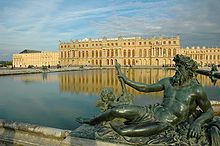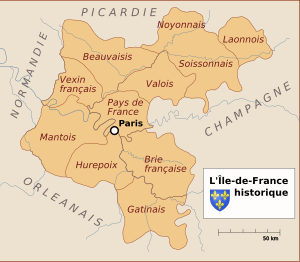This is an old revision of this page, as edited by 90.168.34.35 (talk) at 19:05, 14 March 2013. The present address (URL) is a permanent link to this revision, which may differ significantly from the current revision.
Revision as of 19:05, 14 March 2013 by 90.168.34.35 (talk)(diff) ← Previous revision | Latest revision (diff) | Newer revision → (diff) For other uses, see Île-de-France (disambiguation).Template:Infobox French region
Île-de-France (French pronunciation: [ildəfʁɑ̃s] ) (literally Island of France; see the Etymology section) is the wealthiest and most populated of the twenty-seven administrative regions of France. It consists mostly of the Paris metropolitan area.
With 11.7 million inhabitants, Île-de-France is not only the most populated region of France, but also has more residents than Austria, Belgium, Finland, Greece, Portugal, Norway or Sweden, with a population comparable to that of the U.S. state of Ohio or to that of the Canadian province of Ontario. It is the fourth most populous country subdivision in the European Union, after England, North Rhine-Westphalia and Bavaria.
Economically, Île-de-France is the world's fourth-largest and Europe's wealthiest and largest region. It is the wealthiest metropolitan area in the European Union, and if it were a country, it would rank as the 15th wealthiest in the world. Île-de-France is also the world's second most important location for Fortune Global 500 companies' headquarters (after the Kantō region).
Created as district de la région de Paris ("the District of the Paris Region") in 1961, it was renamed after the historic province of Île-de-France in 1976, when its administrative status was aligned with the other French administrative regions created in 1972. Its name literally means "Island of France", possibly from ancient Frankish Liddle Franke, "little France". Despite the name change, Île-de-France is still popularly referred to by French people as the région parisienne (the "Paris region") or RP. However, its inhabitants are more and more referred to as "franciliens", an adjective created in the 1980s. Ninety percent of its territory is covered by the Paris aire urbaine ("metropolitan area") which extends beyond its borders in places.
Etymology







Although the modern name "Île-de-France" clearly means "Island of France", the etymology is in fact unclear. The "island" may refer to the land between the rivers Oise, Marne and Seine, or it may also have been a reference to the Île de la Cité, in which case "Island of France" was originally a pars pro toto or perhaps a metonym.
Yet another possibility is that the term is a corruption of a hypothesized Frankish language term "Liddle Franke" meaning "Little France" or "little Frankish land", so the modern reference to an "island" may be coincidental. However, this theory might be anachronistic, since the name "L'Île-de-France" (its old spelling) is not documented prior to 1387.
History
Main article: History of Île-de-FranceThe province, also known as Isle de France (as it was once written, as sometimes in English, especially in old publications) is a historical province of France, and the one at the centre of power during most of French history. The historical province is centred on Paris, the seat of the Crown of France, but it does correspond to the present-day région Île-de-France: some parts of the historical province now are incorporated in the present-day region of Picardy, whereas other parts of the present-day région Île-de-France are taken from the historical province of Champagne.
The name Isle de France first appeared in 1387 when the term "France" began to designate territories of the Crown, replacing the pays de France ("pays" means "region/county" as well as "country"). Literally "Island of France", the name was derived from the area's situation with the rivers Seine, Marne, Oise and Beuvronne, which surround it like an island. The name may also inherit from the Frankish Lidle Franke / Lilde Franke, or, "little France". That is, because the "French"/Frankish kings were bilingual until the 12th or 13th century, the Frankish expression may have evolved when Francia ("Franko/n", "Franke", or "Franchonolant" in Frankish) no longer meant the entire Frankish Empire but the smaller West Francia, and later the—even smaller—"Pays de France". The expression "Lidle Franke" / "Lilde Franke" may have persisted until the 13th century when locals quit pronouncing the "s" in "isle"; then "Lilde France" [lildəfrãntsə] would have been difficult to distinguish from l'Île-de-France (IPA: ).
The area around Paris was the original personal domain of the king of France, as opposed to areas ruled by feudal lords of whom he was the suzerain. This is reflected by divisions such as the Véxin Français and the Véxin Normand, the former being within the King of France's domain, the latter being within the Duke of Normandy's fief.
Historic subprovinces of the Île-de-France and their principal cities

The Île-de-Province was divided into several subprovinces (French: pays). They were not administrative areas, but historic and cultural areas going back to the Western Roman Empire and readily identified by their inhabitants. Here is a list of the pays which made up the Île-de-France province, with their principal cities:
- Beauvaisis – Beauvais
- Brie française – Brie-Comte-Robert
- Gâtinais français – Nemours
- Hurepoix – Arpajon, Limours
- Laonnois – Laon
- Mantois – Mantes-la-Jolie
- Noyonnais, Quart de Noyon – Noyon
- Parisis (also known as Pays de France) – Paris
- Soissonnois – Soissons
- Vexin français – Magny-en-Vexin
- Valois – Crépy-en-Valois
Modern history
4 February 1959: The District of the Paris Region ( Error: {{Lang}}: text has italic markup (help)) was created by a government decree. This proved to be a failure, due to a lack of cooperation from the communes and the departments of the region; they refused to send their representatives to the district council.
2 August 1961: The District of the Paris Region was re-created with the same name, but this time by a statute (bill) voted by the French Parliament. The borders of this new region were coterminous with those of the current Île-de-France region. The district council of the aborted 1959 District of the Paris Region was replaced by a Board of Trustees, half of whose members were appointed by the French government, and the other half by the local communes and departments. The executive of the district was a civil servant, the Delegate General for the District of the Paris Region, appointed by the French government.
10 August 1966: Creation of the Prefecture of the Paris Region, whose borders were coterminous with those of the District (and to that of the current Île-de-France region). The Delegate General for the District of the Paris Region was made Prefect of the Paris Region, holding both offices at the same time.
17 December 1966: The district was renamed from "district de la région de Paris" to "district de la région parisienne". The English translation remains the same.
6 May 1976: The District of the Paris Region was transformed into the Île-de-France region, thus aligning the status of the region with that of the other French regions, created in 1972. The Prefecture of the Paris Region was renamed Prefecture of Île-de-France (Préfecture de L'Île-de-France). The former Board of Trustees was replaced by a regional council, 70% of whose members were the representatives of the departments and communes of Île-de-France. The remaining 30% were chosen by the Members of the French Parliament whose constituencies lay inside Île-de-France. The regional council elected a president with limited executive powers. The office of Delegate General was abolished. It was said that President Valéry Giscard d'Estaing personally insisted on choosing the name "Île-de-France" for the region, instead of the previously-used Région Parisienne. Île-de-France was the name of the historical province that existed before the French Revolution, but the name had long since fallen out of use. Today, many people and even some official institutions still continue to use the term Région Parisienne instead of the official name.
2 March 1982: Île-de-France, like the other French regions, was turned into a "territorial collectivity". In other words, it was transformed from a mere administrative region of the state to a full-fledged political entity, on a par with the departments and communes. The powers of the regions were expanded, direct elections of the regional councils were scheduled, and the presidents of the regional councils were given full executive powers.
16 March 1986: The first direct election of the regional council by the inhabitants of
- Global 500 by Country Fortune
- See map.
- The flag is the France Moderne coat of arms (a simplified version of the France Ancien reduced the number of fleurs-de-lis to three), emblem of the French Monarchy, symbole of Île-de-France's prominence
- Template:Fr icon Paris Chamber of Commerce and Industry, Contribution des CCI de Paris – Île-de-France à la révision du SDRIF, page 110. "TEM Paris – La Défense – QCA" (PDF). Archived from the original (PDF) on 2007-03-02. Retrieved 2007-09-01.
{{cite web}}: CS1 maint: multiple names: authors list (link) CS1 maint: numeric names: authors list (link) - France.com